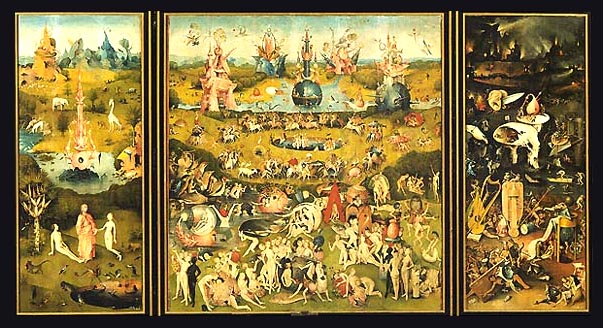

Some background on
Hieronymus Bosch
by William Max Miller
Without a
doubt, The Garden of Earthly Delight is one of the strangest paintings in
the long history of art. Hieronymus Bosch, who executed this enigmatic work in
the early 16'th century, has been acclaimed as an early explorer of the
unconscious mind, praised as a forerunner of the 20'th century Surrealists, and
also condemned as a madman.
Hieronymus Bosch (1450?--1516)
was born in the town of 's-Hertogenbosch in the Netherlands, and although he
spent most of his life in this provincial environment, his fame as a painter of
obsessively detailed and disturbing religious works spread throughout the late
Medieval world. His paintings are filled with apocalyptic images of hellfire and
damnation, and seem to hint at other, incomprehensible terrors that burrow far
beneath their overt eschatological concerns into the subterranean depths
of the subconscious. You may view one of his best known paintings, The Garden
of Earthly Delight, by clicking on the thumbnails at left. (Downloads are a
little slow, but the images are large and of good
quality.)
The symbolism of this remarkable triptych appears to be
right out of a nightmare. A multitude of figures intertwine in such fantastic
and intricate patterns that the eye becomes easily confused by the complex
imagery. People mingle deliriously with plants, animals and monsters, and all
are leaping, dancing, running, copulating, defecating, and tormenting each other
with an almost convulsive frenzy.
The
three panels of The Garden of Earthly Delight depict man's fall from the
Garden of Eden and illustrate the hellish fate which awaits those who succumb to
sensual temptations. The right panel shows Adam and Eve standing with Christ in
the primordial paradise, but even here the modern interpreter encounters
disturbing elements. The strange landscape in the distance and the odd behavior
and appearance of some of the animals indicate that all is not quite what it
seems even in Eden. The central panel illustrates all the carnal pleasures of
worldly existence. Humans frolic with animals and other hybrid creatures in a
frantic debauch of nightmarish intensity. The third panel shows us the torments
of Hell, and here Bosch demonstrates his dark genius for devising instruments of
torture. People are being cut, sliced, burned, skewered, and devoured by a horde
of demonic monstrosities while the eternal fires of the pit rage undyingly
in the background.
Theories regarding the deeper meaning
of this startling imagery abound. In 1947, German art historian Wilhelm Fraenger
argued that Bosch belonged to an heretical sect called the Adamites which
performed secret, orgiastic rituals. These clandestine rites, according to
Fraenger, were portrayed in some of Bosch's paintings. Another opinion claims
that Bosch was an alchemist, and that he incorporated alchemical allegories and
symbolism into his works. Carl Jung viewed Bosch's startling symbolism as
ultimately deriving from the collective unconscious. Dirk Bax and Walter
Bosing forgo psychoanalytical interpretation, and contend that the bizarre
imagery used by the Netherlandish painter only seems mysterious because
it is all based on parables, puns, and folk tales that are obscure or totally
forgotten by us today, but which were commonplace and easily understood by 15'th
century viewers. The most recent theory, propounded by Lynda Harris, claims
that Bosch was influenced by the doctrines of the Cathars, another Medieval
heretical movement.
Today,
our initial reaction to this lurid triptych is typically one of revulsion. Both
its subject matter and its obsessively detailed composition make it repellant to
contemporary tastes. But there is also an undeniable fascination. The painting
seems to challenge the viewer's ability to visually comprehend all its confusing
intricacies. Most people are left with the impression that they have missed
certain details, and typically remark, after subsequent viewings, that they see
something different each time they examine this work. An acquaintance of mine
actually developed the irrational conviction that the figures in the central and
right panels had moved to different positions every time he studied the
painting, and swore that new figures appeared from time to time. Although
this type of delusion is rare, it helps illustrate the impact which Bosch's work
can have on the imagination.
The Garden of Earthly Delight, now
displayed in the Museo Nacional del Prado in Madrid, Spain, is undoubtedly a
disturbing thing to behold, but this has not prevented it from being widely
reproduced and successfully marketed. It continues to exert a powerful
fascination even though the worldview which inspired its creation lay 600 years
in the past.
Are you bewildered by Bosch? Read
Stanley Meisler's
key to the symbolism used by this enigmatic
artist.
Understanding
Bosch's
Symbolism
Then explore the most
comprehensive collection of
Hieronymus Bosch links on the World Wide
Web:
Bosch Resources
Online
Return to The Seventh Tower